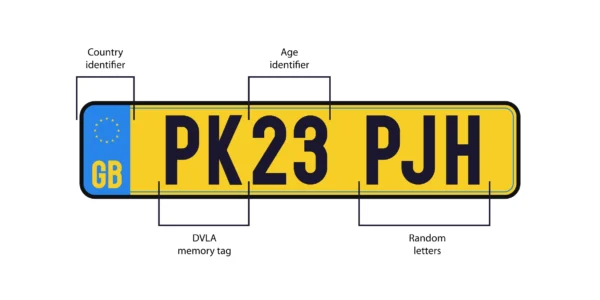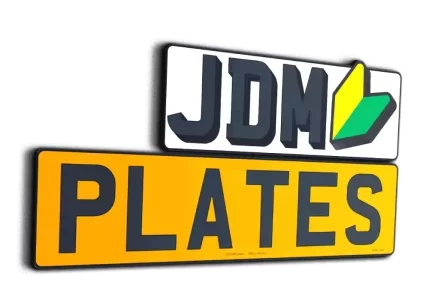How To Read UK Number Plates: Understanding the Current Number Plate System
Unlocking the Code Behind Every UK Number Plate
If you’ve ever wondered what all the letters and numbers on UK number plates mean, you’re not alone. The UK’s number plate system holds a surprising amount of information, from age identifiers to local memory tags. Whether you’re trying to decode a personalised number plate, spot the origin of a private plate, or understand the current number plate system, this guide is here to help.
At JDM Plates, we sell road-legal and custom plates and help drivers understand what their registration plate represents. In this post, we break down how to read UK number plates, including the meaning of those two letters, the registration year, and even how to spot a green number plate used for zero-emission cars.
What Is the Current UK Number Plate Format?
Since 2001, the UK has used a standardised format for new registrations known as the current number plate system. This format includes:
- Two letters (the local memory tag)
- Two numbers (the age identifier)
- Three random letters
For example, a number plate reading LC71 ABC reveals several details:
- LC is the local memory tag, indicating where the vehicle was registered (in this case, a London DVLA office)
- 71 is the age identifier, showing it was registered between September 2021 and February 2022
- ABC is a random sequence for uniqueness
What Is a Local Memory Tag?
The first two letters on a UK number plate refer to the local DVLA office where the car was registered. This is known as the memory tag. Each region in the UK has unique letter combinations:
Common London Memory Tags:
- LA–LY: Various London boroughs
- LC, LD, LF, LH, LP, LR: Assigned to different offices in Greater London
- GJ, GK, GL, GU, GX, GY: Some used historically or shared with adjacent regions
So, if a plate begins with LP, it likely came from the London County Council area. Recognising these DVLA memory tags helps identify where the car was registered.
How Does the Age Identifier Work?
The two digits after the memory tag are the age identifier, which tells you when the car was registered.
- March registrations use the last two digits of the year. For example, 23 for March 2023.
- September registrations add 50 to the year’s last two digits. So, 73 indicates a September 2023 registration
| Year | March Identifier | September Identifier |
| 2022 | 22 | 72 |
| 2023 | 23 | 73 |
| 2024 | 24 | 74 |
This part of the UK number makes it easy to spot whether a vehicle is brand new or from a few years ago, making it especially useful when evaluating used car number plates.
What Do the Final Three Letters Represent?
A computer chooses the last three random letters on a UK number plate to ensure each registration mark is unique. While they may look random, they are essential in tracking and verifying a vehicle’s identity.
These letters avoid offensive combinations or ones that could be misread. Sometimes, these final characters spell a name or word, which is why they’re popular in personalised plates.
What About Green Number Plates?
You may have noticed some number plates with a green strip or green background on the left-hand side. These are green number plates, introduced in 2020 to distinguish zero-emission cars, such as fully electric vehicles.
Key Details:
- Only available for electric vehicles with zero tailpipe emissions
- Optional, but increasingly common for new cars
- Helpful in spotting EVs eligible for cheaper parking, priority parking, and entry into low-emission zones
Green plates can be used with personalised and private registration plates as long as the vehicle qualifies.
Optional Symbols on Number Plates
In addition to the alphanumeric characters, UK number plates may include:
- The Union Flag (commonly referred to as the Union Jack)
- The national flag of England (St George’s Cross), Scotland (St Andrew’s Cross), or Wales (Red Dragon)
- A blue strip with the EU logo (on older plates)
These symbols can help indicate nationality or region and are typically placed on the left-hand side of the plate, similar to the green strip for EVs.
Reading Private Plates and Personalised Registrations
Unlike standard plates, a private number plate or personalised plate may follow a different structure. These can include older formats such as:
- Prefix plates: A single letter (denoting the year) at the start
- Suffix plates: A single letter at the end
- Dateless plates: No obvious year indicator
Many private registration plates are purchased to hide the age of the vehicle, or to spell out names, initials, or words using the combination of letters and numbers. For example, JDM 1 could be a custom plate representing the company.
Why Learn How to Read UK Number Plates?
Understanding how to read a UK number plate isn’t just useful trivia; it can help with:
- Identifying when a car was registered
- Spotting electric vehicles and green plates
- Evaluating the value or age of used cars
- Decoding a private plate or registration mark
Whether you’re browsing new cars, buying a used model, or investing in a personalised number plate, being able to interpret the number plate system helps you make more informed choices.
Decoding UK Plates
The UK number plate system might initially seem complex, but it becomes much easier to read once you understand the format, local memory tag, age identifier, and random letters.
Whether you’re spotting an electric vehicle with a green strip, curious about a London-registered car like LC, LP, or LF, or considering a private plate, the information is all there, just waiting to be decoded.
JDM Plates offers a wide range of registration plates, including green number plates, personalised plates, and replacement plates for any vehicle. Explore our online shop or use our Number Plate Generator to design your own.

While this guide mainly explains the current UK number plate format introduced in 2001, it is worth noting that not all registration plates follow this modern structure.
Many vehicles, particularly classic cars or those with personalised registrations, may display older number plate formats which follow entirely different rules. These include prefix plates, where a letter at the beginning indicates the vehicle’s registration year (for example, A123 XYZ), and suffix plates, where the year identifier appears at the end (for example, XYZ 123A).
There are also dateless number plates, which contain no obvious year indicator at all. These dateless plates are especially popular among collectors and motorists who prefer to hide the age of their vehicle.
If you come across a plate that does not match the two-letter, two-number, three-letter pattern of the current system, it is likely following one of these older formats, so it is important to consider the type of registration before attempting to decode it.

